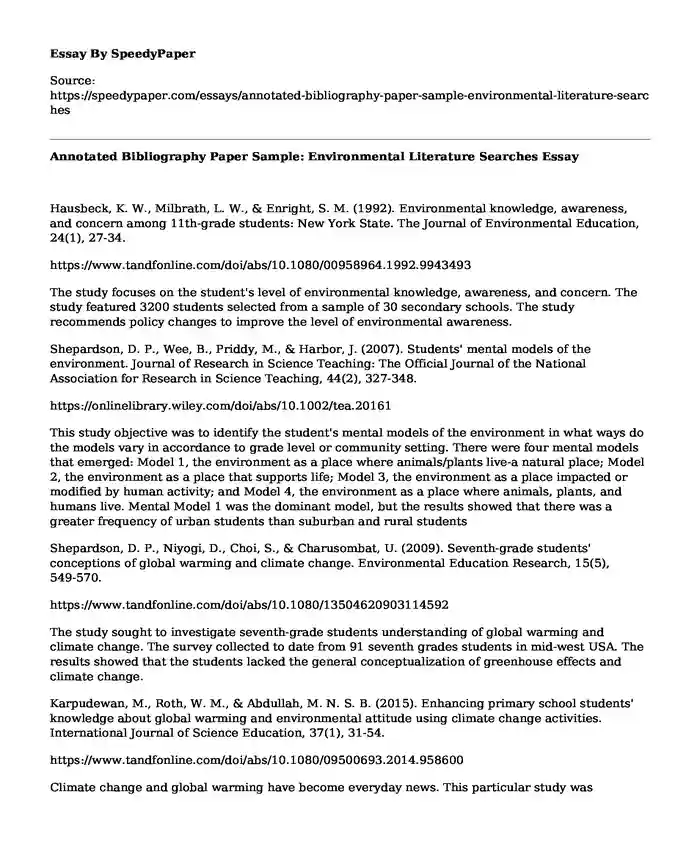
| Type of paper: | Annotated bibliography |
| Categories: | Climate change |
| Pages: | 3 |
| Wordcount: | 621 words |
Hausbeck, K. W., Milbrath, L. W., & Enright, S. M. (1992). Environmental knowledge, awareness, and concern among 11th-grade students: New York State. The Journal of Environmental Education, 24(1), 27-34.
https://www.tandfonline.com/doi/abs/10.1080/00958964.1992.9943493
The study focuses on the student's level of environmental knowledge, awareness, and concern. The study featured 3200 students selected from a sample of 30 secondary schools. The study recommends policy changes to improve the level of environmental awareness.
Shepardson, D. P., Wee, B., Priddy, M., & Harbor, J. (2007). Students' mental models of the environment. Journal of Research in Science Teaching: The Official Journal of the National Association for Research in Science Teaching, 44(2), 327-348.
https://onlinelibrary.wiley.com/doi/abs/10.1002/tea.20161
This study objective was to identify the student's mental models of the environment in what ways do the models vary in accordance to grade level or community setting. There were four mental models that emerged: Model 1, the environment as a place where animals/plants live-a natural place; Model 2, the environment as a place that supports life; Model 3, the environment as a place impacted or modified by human activity; and Model 4, the environment as a place where animals, plants, and humans live. Mental Model 1 was the dominant model, but the results showed that there was a greater frequency of urban students than suburban and rural students
Shepardson, D. P., Niyogi, D., Choi, S., & Charusombat, U. (2009). Seventh-grade students' conceptions of global warming and climate change. Environmental Education Research, 15(5), 549-570.
https://www.tandfonline.com/doi/abs/10.1080/13504620903114592
The study sought to investigate seventh-grade students understanding of global warming and climate change. The survey collected to date from 91 seventh grades students in mid-west USA. The results showed that the students lacked the general conceptualization of greenhouse effects and climate change.
Karpudewan, M., Roth, W. M., & Abdullah, M. N. S. B. (2015). Enhancing primary school students' knowledge about global warming and environmental attitude using climate change activities. International Journal of Science Education, 37(1), 31-54.
https://www.tandfonline.com/doi/abs/10.1080/09500693.2014.958600
Climate change and global warming have become everyday news. This particular study was designed to test the effects of child-centered 5E learning cycle-based climate change activities compared to traditional teacher-centered methods
Scherberger, A. (2011). CONSERVATION AND CHRISTIANITY: Outcomes and Values Driving Faith-based Conservation.
https://dukespace.lib.duke.edu/dspace/bitstream/handle/10161/3666/AllisonScherberger_FinalMP.pdf?sequence=1
Environmental conservation efforts using faith-based organization is compassionate and evolving frontline, but issues surround it due to misunderstandings. The study objective was to seek clarification on the role of religious groups and what they are doing in promoting environmental conservation.
Sehannie, P. (2010). FAITH-BASED ENVIRONMENTAL STEWARDSHIP: PRACTICES AND ATTITUDES OF CHRISTIAN CHURCHES ON VIRGINIA'S NORTHERN NECK AND EASTERN SHORE.
https://scholarscompass.vcu.edu/cgi/viewcontent.cgi?article=3324&context=etd
The primary objective of the study was to investigate the environmental practices and attitudes of two Christian churches in Virginia. The results showed that policymakers could create a partnership with religious institutions to promote environmental sustainability
Nichols, A. M. (2015). Revolutionizing the modern environmental discourse: religion, revolution, and mountaintop removal (Doctoral dissertation, University of Missouri--Columbia).https://mospace.umsystem.edu/xmlui/handle/10355/50175
This study explores how academic study of religion will help in dealing with environmental challenges. The study incorporates the emergence of practical ethics in Buddhism which discourages environmental degradation.
HaluzaDeLay, R. (2014). Religion and climate change: varieties in viewpoints and practices. Wiley Interdisciplinary Reviews: Climate Change, 5(2), 261-279.
https://onlinelibrary.wiley.com/doi/abs/10.1002/wcc.268
Despite religion institutions being the most common in the society, there has been little focus on how religion interacts with human-induced climate change. This research explores various religious viewpoints and practices in regards to climate change. The Pacific Islands were used as the geographical case study and Buddhism was used as a case study of a specific faith tradition.
Cite this page
Annotated Bibliography Paper Sample: Environmental Literature Searches. (2022, Aug 22). Retrieved from https://speedypaper.com/essays/annotated-bibliography-paper-sample-environmental-literature-searches
Request Removal
If you are the original author of this essay and no longer wish to have it published on the SpeedyPaper website, please click below to request its removal:
- Life Changing Event Essay Sample
- Research Paper Sample on Career Self Management
- The Flowering of Christianity, Essay Sample in Religion
- Free Essay Providing a Critical Examination of the Specified Book on Pearl Harbor
- Free Essay with Hemingway's "Hills Like White Elephants" Review
- Essay Sample on Cause and Effect of Cigarette Smoking
- Essay Sample on The Significance of Music
Popular categories




